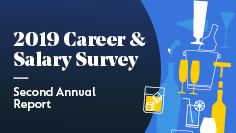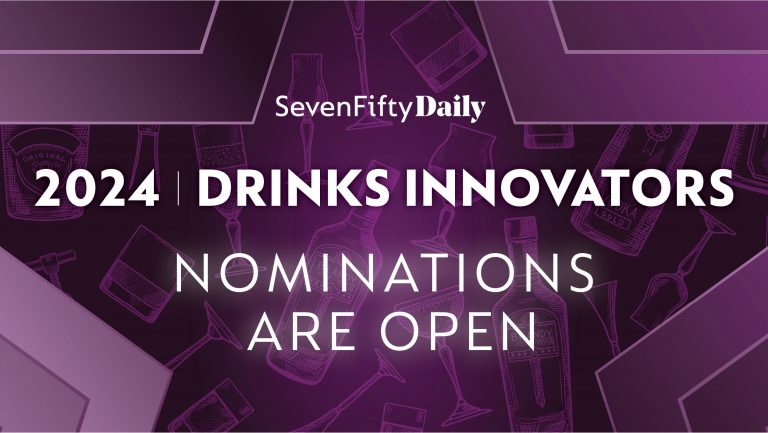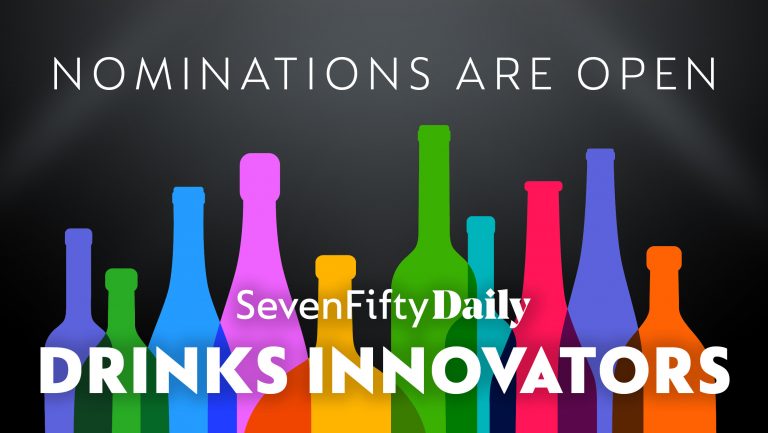From workplace concerns involving equal pay and executive representation to the quickening pace of climate change and its effects on producers, the beverage alcohol industry is experiencing a period of intense self-reflection.
“In many ways,” says Aaron Sherman, SevenFifty’s CEO and cofounder, “this industry feels rooted in tradition and regulations. At the same time, it’s a rapidly evolving landscape, where workplace culture, consumer trends, and market forces continually redefine the path forward. This year’s survey results revealed to me just how complex and dynamic today’s workplace is for both businesses and individuals.”
As a follow-up to last year’s landmark survey, SevenFifty and SevenFifty Daily canvassed approximately 3,100 beverage alcohol professionals to seek their opinions on a variety of issues facing the industry. The study was once again conducted by Wine Opinions, a leading provider of U.S. market research for the wine industry. The study revealed some intriguing shifts from last year’s findings and many fascinating insights.

Don’t miss the latest drinks industry news and insights. Sign up for our award-winning newsletters and get insider intel, resources, and trends delivered to your inbox every week.
SevenFifty Daily sent an advance copy of the final survey report to industry leaders and asked for their opinion on the most pressing issues that face the future of the industry.
The Gender Pay Gap and Equal Opportunity for Women
One issue that saw incremental progress over last year’s study was the gender pay gap. Once again, the 2019 survey showed that men make more in annual salary than women in the beverage alcohol industry (on average, $12,000 more). Still, this represents a 1.6 percent improvement since last year’s study. Whether this represents true progress—or a statistical anomaly—only more time and data will tell.
Nonetheless, the gender pay gap initiated quite a bit of conversation among industry leaders. “This is an important topic that has a direct effect on the competitiveness of companies,” says Michelle Korsmo, the president and CEO of the Wine & Spirits Wholesalers of America (WSWA). “[It is] an issue that WSWA member companies are addressing in their own initiatives and through the association.”
According to Korsmo, one of the ways the WSWA is addressing the gender pay gap and the underrepresentation of women within the wholesaler side of the industry is through the Women’s Leadership Council (WLC). Founded by the organization three years ago, the council is dedicated to “educate, elevate, and empower women in the wholesale tier,” says Korsmo. “WLC is an example of how companies that put specific attention on increasing diversity will benefit from the development, promotion, and retention of women.”
For Master Sommelier June Rodil, a partner at the Goodnight Hospitality restaurant group, a slight closing of the gender pay gap from 2018 and 2019 was not nearly enough. “Even though there are signs of improvement,” she says, “it was a little bit less than I expected.”
There are two reasons that Rodil expected more of a narrowing of the gap in the last year—the large volume of open jobs in the wine industry, and the number of women pursuing certification with the Court of Master Sommeliers and the Wine & Spirits Education Trust (WSET). “I would have thought,” she says, “that these would have led to more job placement opportunities in general.”
“Any part of a pay gap being caused by discrimination must be eliminated,” says Aaron Smith, the executive director of the United States Bartenders’ Guild (USBG). For his sector of the industry, the gender pay gap—as well as substandard benefits—promotes attrition in the field and causes professionals to seek employment in other industry tiers.
“Observationally,” says Smith, “we see that hospitality professionals often move into distribution or supplier firms when they [are seeking] better personal and family benefit packages.”
Leaders also offered suggestions on ways in which the gap can be narrowed, including improving pay transparency and addressing diversity and inclusion. “I’d like to see the beverage industry take a leading position in the business world and equalize compensation for men and women,” says Laura DePasquale, MS, the vice president and general manager of Artisanal Fine Wines, a division of Southern Glazer’s Wine & Spirits Florida. One way of doing this, she suggests, is a practice referred to as compensation banding, whereby a company establishes a set range of pay for particular roles or functions.
Adam Sager, the copresident of Winesellers, Ltd., believes that effecting change starts at the top for the importer tier. “Employers can make a commitment,” he says, “to be open and inclusive of female candidates in executive-level hiring.”
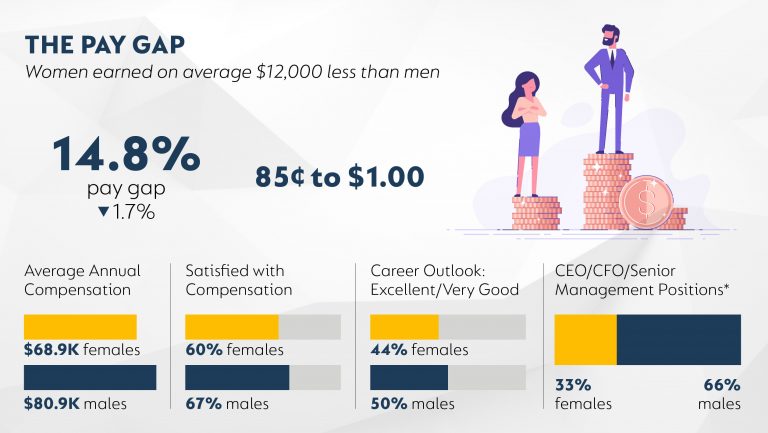
Which Workplace Policies Matter Most
Respondents to our survey also revealed that healthcare benefits, flexible work arrangements, and antiharassment policies are currently the most top-of-mind concerns in the workplace. Since healthcare costs continue to rise across the U.S., it’s perhaps not surprising that workers in the beverage alcohol industry are worried about coverage.
The survey found that today’s beverage alcohol professionals are increasingly seeing flexible work hours as an important benefit. Of the 3,100 survey respondents, 71 percent rated flexible work arrangements as centrally important to their job satisfaction, with women placing more emphasis on flexibility than men (78 percent versus 66 percent, respectively). This is a trend frequently encountered by Julia Herz, the craft beer program director at the Brewers Association.
“Scheduling can truly be a barrier,” Herz says, regarding general career advancement for women in the industry. “Somebody—and it’s often the woman—has to bear the load of, for example, a child’s schedule.” Without the proper amount of flexibility, she says, many cannot hold down the particular job. “If you are wanting to attract career-minded employees, then you’re going to really want to look at giving some flexibility to the men and women who are parents.”
Antiharassment policies were also on respondents’ minds: 65 percent indicated the importance of such workplace policies, and while this was seen across all tiers of the industry, it was particularly apparent with on-premise employees.
“We have seen a number of establishments adopting unique and progressive antiharassment policies over the past couple of years,” says USBG’s Smith. “Industry-wide, we could use more education on bystander intervention and recognizing interpersonal violence as a problem that can be addressed and resolved.”
Rodil of Goodnight Hospitality urges industry leaders to implement strong antiharassment protocols, adding that this is best done at a new company’s inception. “It’s always harder to move a ship,” she says, “when it’s already on the water.”
Rodil adds further that investing in human resources—whether internally, with a highly trained human resources director, or through an established third party—not only fosters a better business, by encouraging a diverse workforce and by establishing enforceable antiharassment protocols, but a more profitable business as well.
“[Human resources] will teach you how to retain your employees,” she says. “New staff is astronomically expensive—in the form of new uniforms, retraining, and the labor hours needed to have a second person do that training. In the end, not retaining a staff is 10 times more expensive than having good human resources.”

The Increased Importance of Industry Certifications
While advanced education through the Wine & Spirits Education Trust (WSET), the Court of Master Sommeliers (CMS), or the Cicerone Certification Program has long been a pillar of career advancement in the industry, the 2019 SevenFifty Career & Salary Survey underscores just how widespread these certifications are.
As expected, participation in the CMS program was high and skewed heavily toward the on-premise trade tier—one-third of those respondents cite some level of CMS certification. Even more prevalent were certifications through the WSET program, with one out of four total respondents stating that they’ve achieved some level of certification with the trust.
“No surprises here,” says Dave Rudman, the executive director of the Wine & Spirits Education Trust (WSET) Americas. “WSET candidate numbers in the U.S. have shown incredible growth. In our last academic year, ending in July, we grew 26 percent over the previous year, with more than 17,000 candidates across all levels for the year.
“Where we are expecting robust growth over the next few years,” he says, “is from large off-premise companies that are looking at demographic shifts, and from the importance of education and training to millennials and Gen Zs.”
Meanwhile, the beer industry has also made extensive progress in expanding the certification of advanced beer knowledge through the Cicerone program. Six percent of total respondents cite this certification, a fact that is not surprising to Herz of the Brewers Association. “It’s time,” she says, for beer in the beverage alcohol space to be treated as an advanced beverage that merits advanced education.”
Cannabis, Climate, and Cans
When the survey asked respondents to anticipate which issues would have the most impact on their side of the industry in the next year—cannabis products and their regulation scored the highest (86 percent of total respondents cited them), even more than that of climate change (80 percent).
“Cannabis is certainly a topic of current interest,” says John Gillespie, the founder and CEO of Wine Opinions. He adds that a separate Wine Opinions survey delivered some welcome news to the wine industry recently: Regular wine drinkers (those who consume several times a week) who also use cannabis are not lowering their wine consumption. It would therefore seem that the beverage alcohol industry has reason to be optimistic that cannabis won’t take away market share.
But, Gillespie says, “climate change is the real threat to our industry. It will soon dwarf all other concerns because it is global in scope and ultimately affects every grape grower, wine producer, and wine drinker. Bordeaux approving the planting of Touriga Nacional should get everyone’s attention.”
Survey respondents are continuing to analyze packaging trends for their products, particularly the wine industry and its adoption of cans. According to a study commissioned by the Mintel Group in 2018, canned wine represented one in 10 product launches tracked last year. Sagar of Winesellers, Ltd., can attest to this fact. “Alternative packaging such as cans, kegs, and creative gift packs have helped us differentiate ourselves from the competitors,” he says. Furthermore, his company has found success with wine sold in recyclable kegs: “We have been able to grow our on-premise distribution with restaurant groups championing wine-on-tap programs [because of the recyclable kegs].”
Lastly, 66 percent of respondents rated international and domestic tax and tariff policies as growing in importance. However, it should be noted that the survey was conducted in mid-to-late summer, before recent news regarding U.S. tariffs on French and Spanish wine.
“All of these trends are certainly top of mind for executives [who] are forward thinking,” adds Artisanal Fine Wines’ DePasquale, who notes that she prefers to look at emerging—and increasingly complex—trends like these as opportunities for channel development, revenue streams, and growth.
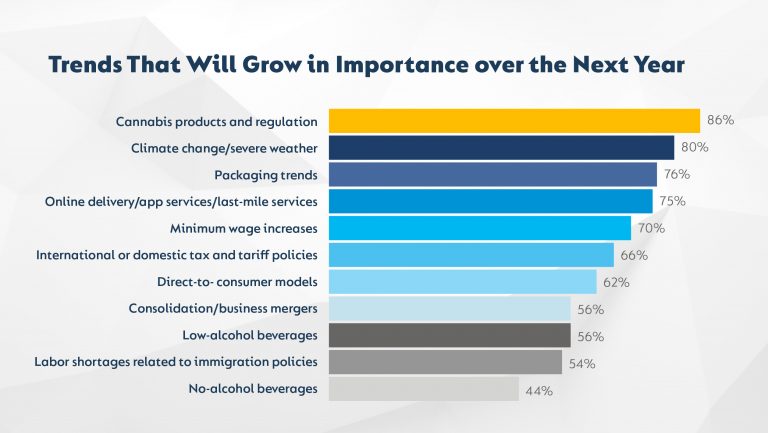
One of the top priorities of the annual Career & Salary Survey Report is to better elicit the fluctuations of key issues facing the beverage alcohol industry, from trending topics to career satisfaction. As Gillespie of Wine Opinions notes, comprehensively charting where the industry is headed will take time.
“Any truly meaningful changes are not usually year to year,” Gillespie says. “We’ll be looking for a trend line over three to five years. That’s where you can reliably say that something is a trend.”
Download the full report on SevenFifty Daily.

Dispatch
Sign up for our award-winning newsletter
Don’t miss the latest drinks industry news and insights—delivered to your inbox every week.
Kevin Day is a wine writer and photographer based in Colorado and the founder of the wine website Opening a Bottle. He is an Italian Wine Scholar with Highest Honors and a member of the International Association of Culinary Professionals. Follow him on Instagram and Twitter @openingabottle.


